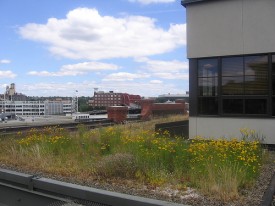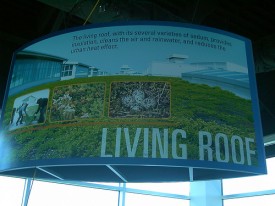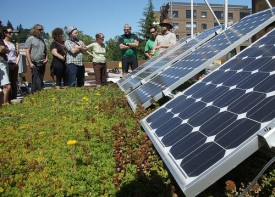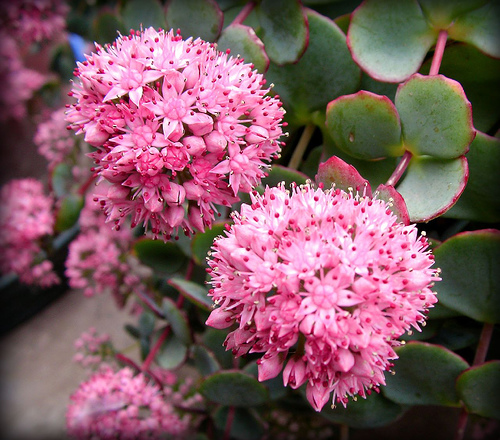The City of Roses is being transformed into the City of Sedums as nearly 300 Portland rooftops are now blanketed in the drought-tolerant succulents.
And as rooftops in Oregon are going green, some of the businesses that design, build, and landscape ecoroofs are having an economic mini boom.
News headlines cheer sales numbers that have tripled in the past year for one Portland company. Another is doing cutting-edge ecosystem research that could help businesses cut costs and benefit the environment. And two local businesses are merging their green products into an exciting new technology.
The enthusiasm for ecoroofs is spilling over into other Oregon cities and counties, including Bend, Salem, and Multnomah County. Libraries, schools and universities, even gas stations and a high school batting cage are sprouting green covers.
Portland is the state’s hothouse for green roof growth. If you include the number of buildings capped in smaller patches of plants and veggie gardens in the tally, there are 428 green roofs in Portland covering 30 acres, officials report.
There are lots of benefits to the roofs. They help soak up stormwater runoff, make roofs last longer, insulate buildings to cut energy costs, plus they look beautiful and can provide a home for bugs, birds, and other wildlife.
“They are becoming part of the fabric of what our city looks like,” said Matt Burlin, outreach coordinator for Sustainable Stormwater Management with the city of Portland’s Bureau of Environmental Services.
Stormwater strategies
Leadership from the Portland city government has been instrumental in elevating the status of rooftops around the city, state, and beyond.
The spark came in 1996 when Tom Liptan, a city employee, installed Portland’s first ecoroof on his garage. He started championing the technology and green roofs slowly began sprouting around the city. Then in 2008, with the confidence gained over a decade of testing the planted roofs in residential and industrial settings alike, Portland took the bold move of offering cash incentives for green roofing.
Their motivation: to increase the use of the roofs as a cost-effective control for the deluge of polluted stormwater that gushes off the city’s buildings, roads, landscaped yards, and parking lots. The cascades of dirty runoff threaten human health and damage the environment, homes, and roadways.
This year, Portland is completing its $1.4 billion Big Pipe project to prevent stormwater and raw sewage from spilling into local waterways through improvements in its traditional sewer infrastructure. The city’s ecoroof incentives complement this “gray” solution on a smaller, more localized, and greener scale. The plan for the green roofs was to keep 17.6 million gallons of water out of the stormwater system by installing 43 acres of absorbent roofing.
So far the city has awarded money to 145 projects that will build 11.9 acres of ecoroofs. The grants, which are part of Portland’s environmentally-focused Grey to Green initiative, pay up to $5 per square foot of green roof.
Incentives fertilize industry

In addition to helping fix Portland’s stormwater problems, the incentives have super charged the growth of the green roof industry.
Jon Crumrine, president of Enviroscapes NW, launched his green roofs and living walls business in 2008.
“The timing of my business is not a coincidence,” Crumrine is quoted saying in a Sustainable Business Oregon article. Crumrine said that when he heard about the incentive program, “I knew this was going to provide the economic lubricant” that would make an ecoroof-focused business possible.
Strong demand for green roofs similarly gave a boost to Columbia Green Technologies, which develops ecoroof systems.
The Portland company reports that sales tripled from $1 million in business last year to orders worth $3.1 million in 2011, according to Sustainable Business Oregon. This June, the company received $500,000 from an angel investor so that it could hire new employees and ramp up its operations in order to meet growing demand.
Holistic growth

But the incentive program won’t last forever, and Portland leaders are looking ahead to when it ends in 2013. They hope by then that the ecoroof industry is a strong, self-sustaining sector that can spread like ivy once the economy picks up again.
That’s why the city is doing more than giving a financial boost to the industry. It’s trying to take a more holistic approach and fostering the creation of a fleshed-out ecoroof business community. It’s doing this by creating a directory of ecoroof-related businesses that now has more than 100 listings. Each spring the city hosts talks and tours showcasing green roofs, and it hosts a lively ecoroof blog. Recipients of the city’s incentives are required to write a report describing their project, and these reports are part of a public database that others can use to design their own ecoroofs.
One of the most important developments was the city’s partnership with industry leaders in establishing “GRiT” – a Green Roof info Think tank with more than 300 members that include ecoroof professionals, government agencies, nonprofit groups, students, and others. The think tank is a place for people to share problems and solutions, but it’s not meant to be an arena to market specific products. Instead, the idea is to build the knowledge base and acceptance of ecoroofs out in the real world.
“If we’re thinking forward, when the economy turns around we want developers to be thinking of an ecoroof as a conventional alternative,” Burlin said. “We want it to be less mystifying and just a tool in the tool kit.”
Burlin said that it’s better if designers, builders, and developers are encouraging their peers to install green roofs, rather than having someone from the city proselytizing their merits. GRiT helps the people interested in ecoroofs hone their skills and make connections to spread the practice.
The group has also worked to lobby for public policies that support ecoroofs. Most recently, GRiT members celebrated a decision by the state’s Construction Industry Energy Board to include ecoroofs in the Oregon Reach Code. The Reach Code is a voluntary energy efficiency code that’s more aggressive than existing code. With this code change, ecoroofs will be recognized as an energy conservation measure and as a way to help reduce urban heat-island effects.
Green roofs save greenbacks

And as the industry has grown, costs for ecoroofs have been shrinking.
Back even before the incentives took off, Portland did a detailed cost-benefit analysis for ecoroofs in 2008. The report concluded that a conventional roof for a large project costs about $10 per square foot, while a green roof on the same building would pencil in at about $15.75 per square foot (see Table 20).
Now green roofs are now running about $8 to $12 a square foot, Burin said, putting them on par with conventional roofs in some cases, though the prices still vary widely and can be higher than that range.
But there are so many other benefits from the roofs that are missed in a straight comparison of installation costs. One ecoroof supporter makes the pitch that when you install a green roof, it’s like getting two roofs for the price of one. That’s because a green roof can last twice as long as a conventional roof. Ecoroofs create a shield from sunlight, a top cause for wear and tear of a roof.
“This isn’t about butterflies, it’s about lifecycle costing,” said Shawn Sullivan, in a great piece from Sustainable Business Oregon. Sullivan has managed three ecoroofs for his employer, Winkler Development Corp.
Additionally, the roofs can provide energy cost savings by insulating a building from hot and cold temperature extremes.
And the city provides other ecoroof enticements beyond the installation incentives. The city offers building owners up to 35 percent off on their stormwater utility bill because the roofs reduce the amount of polluted runoff pouring into the city system. Monitoring studies done in Portland find that the roofs capture half the rain that falls on them, keeping that water out of overwhelmed storm-sewer systems. It also greatly slows the flow of water during downpours, preventing spills of sewage waste.
For ecoroofs installed in the Central City Plan District, Portland awards a “floor area ratio bonus” that allows developers to build an additional square foot of space for each square foot of green roof.
The future: habitat roofs and solar

With green roofs, butterflies and the bottomline can both come out ahead.
At least that’s the hope for Portland’s Gunderson LLC, which announced in June that it was building a 1,000 square foot “habitat roof” on a building that covers industrial fuel tanks. While the installation will provide stormwater benefits inherent to green roofs, the focus of the project is on how living roofs can provide habitat for birds and bugs.
GRiT members teamed up to help Gunderson plan the roof. A Daily Journal of Commerce story explained the motivation for the project:
“We’re hoping to get as much information as possible on what works and what doesn’t,” said Soren Hill, a hazardous materials technician at Gunderson. “Hopefully we can make something of a case study from this project that can benefit us and others who are advocating for these types of structures around industrial areas.”
Based on what’s learned from the smaller project, Gunderson is planning to build another, much larger habitat roof on top of its hazardous waste storage area. And as Oregon Sustainable Business reported, having Gunderson embrace green roofs could add up to sizable changes: the company owns 20 acres of rooftops.
There’s another important aspect to the story, Portland officials explained. The city’s River Plan, which is designed to benefit the Willamette River, requires habitat mitigation for shoreline projects. If the habitat roofs perform as hoped, they might be able to fulfill some of those needs.
And finally, ecoroofs aren’t just about habitat, stormwater, and cost savings, now they’re also about energy. In August, Columbia Green Technologies and Solterra Systems finished installing a 5,600 square-foot combo green roof and solar panel project on a Portland rooftop.
Portland State University researchers a year ago installed a smaller green-solar roof combination on top of a university building as part of what was billed as a “groundbreaking study.” The PSU scientists are also going to monitor the larger Columbia Green and Solterra project to better understand how the green technologies can play together.
Projects like these that test the bounds for the environmental, economic, and power potential of ecoroofs show just how far the sector has come in less than two decades thanks to strategic policy decisions and an energized industry.
“Rooftops,” said Portland’s Burlin, “are no longer a dead space.”


Comments are closed.